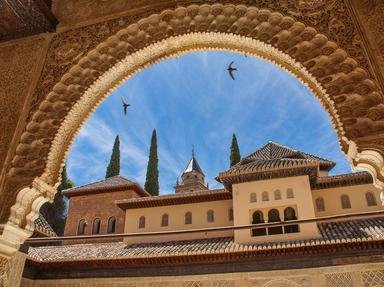Quiz Answer Key and Fun Facts
1. "The rain in Spain fell on this scene of strain"
The stadium that hosted the athletics events at the 1992 Olympics, along with both the opening and closing ceremonies for the games, is located on the slopes of which hill in the city of Barcelona?
2. "The rain in Spain comes down upon my brain"
The University of Salamanca was granted its Royal Charter in 1218 by King Alfonso IX of Leon, making it the oldest university in Spain. Which author, famous for a 17th-century literary work about a man from La Mancha's attempt to revive the art of chivalry, is often claimed to be an alumnus of this university?
3. "The rain in Spain soaked a poor common crane"
The common crane, a migratory species that often winters in western Spain, has what tautonymous Latin name?
4. "The rain in Spain falls from under my plane"
To which Spanish city would you be flying if your plane was due to land at an airport named after the poet Federico Garcia Lorca?
5. "The rain in Spain gurgled into the drain"
Located on the site of a former sewer and storm water drain, what is Barcelona's La Rambla?
6. "The rain in Spain fell throughout the King's reign"
The reign of which 'spirited' Spanish King triggered the War of the Spanish Succession in 1701?
7. "The rain in Spain got in amongst the grain"
Rice is a key ingredient of which dish that originated in the Valencia region of Spain?
8. "The rain in Spain rumpled the horse's mane"
Which autonomous community of Spain gives its name to the breed of horse also known as the Pure Spanish Horse or PRE?
9. "The rain in Spain didn't put off this Dane"
Princess Sophia of Denmark and which other European country married the future King Juan Carlos of Spain in 1962?
10. "The rain in Spain stays mainly on the chain"
In which chain of mountains, with a name meaning 'snowy range', could you find the highest peak in mainland Spain?
Source: Author
Fifiona81
This quiz was reviewed by FunTrivia editor
trident before going online.
Any errors found in FunTrivia content are routinely corrected through our feedback system.

